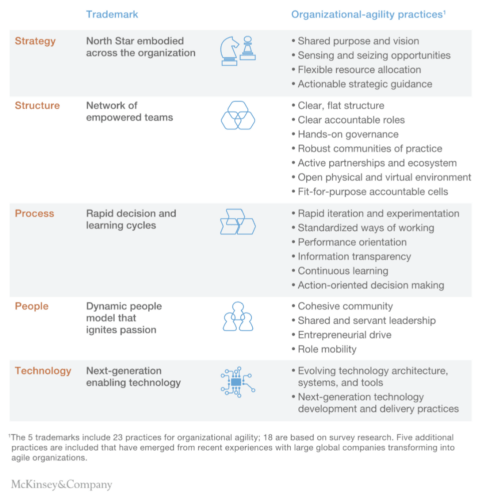The Agile Challenge
“Agile” is a relatively recent buzzword in the consulting world. In October 2020, McKinsey conducted a survey of over 2,000 companies to understand their efforts to become more agile and the level of success they had achieved. Surprisingly, 50% of the companies surveyed were doing nothing in this regard. Among the remaining 50%, two-thirds claimed to be pursuing transformation but were essentially treading water with no decisive action and minimal or no discernible business impact. Only 10% of the remaining one-third reported successful agile transformations.
Clearly, the investment in agile transformation often falls short of the desired outcomes. How agile do you believe your company and team are? If you’re unsure about how to evaluate your team or company, consider using McKinsey’s Five Trademarks of Agile Organizations (see the image below).

The Barrier of Fragility
So, what makes agility so challenging to attain? In any strategic initiative or execution of a vision, it’s just as important to identify and deeply understand the barriers and inhibitors to success as it is to articulate the strategy and vision. The intangible barriers to success are often the most challenging to acknowledge and identify.
One of the most frequently overlooked barriers to agility is fragility. Being agile necessitates continuous learning and growth. It means embracing volatility and uncertainty rather than fearing them. Agile individuals welcome change rather than feeling threatened by it. Agility requires flexibility, adaptability, and resilience. Fragility, on the other hand, undermines all of these qualities. In fact, fragility inhibits the very kind of growth that humans and most organisms excel at: growth through adversity. This concept is central to Nassim Taleb’s thesis in his brilliant book, ‘Antifragile.’
Taleb argues that the opposite of fragility is not durability but something that becomes stronger under stress. Lacking an existing English word for this idea, Taleb coined the term ‘antifragile.’ Herein lies the problem: by catering to people’s inclination for fragility, we deny them the opportunity to develop agility. This trend is observable in our child-rearing practices, educational institutions, and even in our efforts to avoid causing offense in discussions related to personal pronouns, race, gender, religion, or ethnicity. Of course, no one should speak or act in ways that are offensive to others. However, instead of insulating ourselves from the possibility of offense, we might benefit more from learning resilience in the face of offensive behavior.
By catering to people’s inclination for fragility, we deny them the opportunity to develop agility.
Cultivating Agility
The tendency to nourish fragility instead of encouraging agility also surfaces in many educational institutions that go to great lengths to ensure that even mediocre students achieve high grades, shielding them from the disappointment of failure. Jill Filipovic wrote an article in The Atlantic this month titled ‘The Resilience Gap,’ discussing the prevalence of trigger warnings before potentially uncomfortable or offensive journalism. This leads Jill to ask whether we have unintentionally raised a generation with fewer tools to handle hardship. Regrettably, it appears that we have. We go to great lengths to curate comfortable environments and experiences for ourselves and others, and to avoid discomfort at almost any cost. We ‘cancel’ individuals who challenge our ideas, create employee-centric cultures to minimize employee discomfort, and even allow employees to work from home in their pajamas to avoid the discomfort of commuting to the office.
Jill Filipovic quotes Martin Seligman, the director of the Positive Psychology Center at the University of Pennsylvania, who noted that about as many people who experience PTSD after military trauma also show something called post-traumatic growth. This means that despite a difficult experience, they emerge stronger physically and psychologically than they were initially. We understand the principles of antifragility and growth through hardship in areas like physical training and sports. We know that avoiding the pain of exertion deprives us of the exhilaration of athletic victory. So why have we become so determined to soften our work and life experience to the point where agility seems unattainable?
We cannot manage for agility and educate for fragility. We cannot pursue agile strategies in fragile cultures. Teams and individuals must learn to master the unexpected, the uncomfortable, and the emotionally, physically, and mentally challenging aspects of their work and lives. Only then can they truly excel in agility.
We cannot manage for agility and educate for fragility. We cannot pursue agile strategies in fragile cultures.
As a leader, one of the most significant favors you can do for your team is to allow discomfort into the team experience. Avoid intervening to shut down comments or behaviors that might create discomfort within the team. Show your excitement when unpredictable events occur that could disrupt your plans, instead turning these challenges into constructive opportunities.
If your team is self-motivated, bright, and competent, they are likely to require less management from their leader, and more wisdom. Your role becomes more about educating than commanding. While always being sensitive to people’s feelings, teach them how to navigate difficulties rather than avoid them. Even without embarking on a formal agile transformation program, your efforts to teach antifragility will deliver the agility that previously eluded you.
My Team at Lapin International is expert at facilitating a safe space for fragility to be challenged and at cultivating emotional agility in a team. If you would like to, please contact me directly at david.lapin@lapininternational.com for further information.
